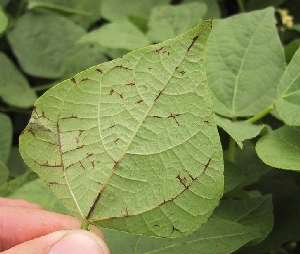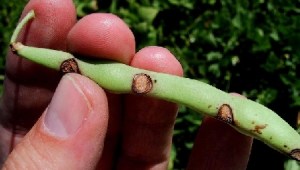Anthracnose on Dry Beans
Anthracnose on beans can reduce both yield and quality. The disease is distinct from the anthracnose that affects lentils.

Figure 1. Darkening and collapse of veins on the leaf underside indicates onset of infection

Figure 2. Sunken lesions on pods showing spore production at the centres.

Figure 3. Seed discoloured by anthracnose infection
Host Crops
Dry beans, fababean
Biology
The fungus that causes anthracnose is seed- and stubbleborne. Production of spores and initial infection is favored by temperatures of 13ºC to 26ºC (55ºF to 79ºF) with an optimum of 17ºC (63ºF). Relative humidity above 92% and free moisture also favor infection. Epidemics are brought on by frequent showers especially accompanied by driving winds.
Symptoms of Damage
Infected seed may exhibit dark brown spots or rings of discoloration. Initial infections are first evident on the underside of leaves as a darkening and collapse of the veins. Angular lesions may later be evident on the upper surfaces. Lesions on stems and pods are crater-like, initially dark brown. In wet weather, light orange masses of spores are produced in the center of the lesions leading to secondary spread by rain splash. Diseased plant material may dry and crack, exposing seeds within the pods. Seed produced beneath pod lesions may or may not show physical signs of infection.
Scouting Techniques
Look for early onset of infection by turning over leaves of plants a short distance into the crop, especially in low spots or where crop is adjacent to stubble of previous year’s bean crop.
Economic Thresholds
None available.
Control Tips
- Plant seed that is as free of anthracnose as possible and/or treat with a recommended fungicide.
- Plant crops other than beans for two to three years before replanting a field to beans. Choose cultivars that are resistant to the common races of anthracnose that are found in your region. There are several common races (ex, alpha, beta, gamma, delta and lambda) and individual cultivars may have resistance to some but not all of them.
- Use a foliar fungicide, if available, should the anthracnose infection be apparent prior to pod development.

